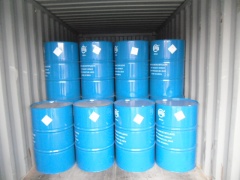Difference between revisions of "Trichloroethylene"
(→Shipment / Storage) |
(→Shipment / Storage) |
||
| Line 30: | Line 30: | ||
==Shipment / Storage== | ==Shipment / Storage== | ||
| − | + | Physical state : liquid<br> | |
| − | Colour | + | Colour :;: colourless<br> |
| − | Odour | + | Odour :;: sweet<br> |
| − | Boiling point | + | Boiling point :;: 87°C<br> |
| − | Freezing point | + | Freezing point :;: -73°C<br> |
| − | Water solubility : 0.1% | + | Water solubility :;: 0.1%<br> |
| − | SOLVENT SOLUBILITY | + | SOLVENT SOLUBILITY<br> |
| − | Soluble | + | Soluble : alcohol, [[ether]], [[acetone]], [[chloroform]], [[benzene]], vegetable oils<br> |
<b>Storage</b><br><br> | <b>Storage</b><br><br> | ||
Keep in a tightly closed container, stored in a cool, dry, ventilated area. Protect against physical damage. Isolate from any source of heat or ignition. Isolate from incompatible substances. Containers of this material may be hazardous when empty since they retain product residues (vapors, liquid); observe all warnings and precautions listed for the product. | Keep in a tightly closed container, stored in a cool, dry, ventilated area. Protect against physical damage. Isolate from any source of heat or ignition. Isolate from incompatible substances. Containers of this material may be hazardous when empty since they retain product residues (vapors, liquid); observe all warnings and precautions listed for the product. | ||
Revision as of 10:34, 8 January 2014
| Infobox on Trichloroethylene | |
|---|---|
| Example of Trichloroethylene |  |
| Facts | |
| Origin | - |
| Stowage factor (in m3/t) | - |
| Humidity / moisture | - |
| Ventilation | - |
| Risk factors | See text |
Trichloroethylene
Contents
Description
The chemical compound trichloroethylene (C2HCl3) is a chlorinated hydrocarbon commonly used as an industrial solvent. It is a clear, non-flammable liquid with a sweet smell. It should not be confused with the similar 1,1,1-trichloroethane, which is commonly known as chlorothene.
The IUPAC name is trichloroethene. Industrial abbreviations include TCE, trichlor, Trike, Tricky and tri. It has been sold under a variety of trade names. Under the trade names Trimar and Trilene, trichloroethylene was used as a volatile anesthetic and as an inhaled obstetrical analgesic for millions of patients.
Most trichloroethylene is produced from ethylene. First, ethylene is chlorinated over a ferric chloride catalyst to produce 1,2-dichloroethane. When heated to around 400°C with additional chlorine, 1,2-dichloroethane is converted to trichloroethylene. This reaction can be catalyzed by a variety of substances. The most commonly used catalyst is a mixture of potassium chloride and aluminum chloride. However, various forms of porous carbon can also be used. This reaction produces tetrachloroethylene as a byproduct, and depending on the amount of chlorine fed to the reaction, tetrachloroethylene can even be the major product. Typically, trichloroethylene and tetrachloroethylene are collected together and then separated by distillation.
In recent times, there has been a substantial reduction in the production output of trichloroethylene; alternatives for use in metal degreasing abound, chlorinated aliphatic hydrocarbons being phased out in a large majority of industries due to possible irreversible health effects and the legal liability that ensues as a result.
Application
- Metal degreasing
- Extraction solvent for oils, fats, waxes
- Solvent dyeing
- Dry cleaning
- Refrigerant and heat exchange liquid
- Fumigant
- Cleaning and drying electronic parts
- Diluent in paints and adhesives
- Textile processing
- Chemical intermediate
- Aerospace operations (flushing liquid oxygen).
Shipment / Storage
Physical state : liquid
Colour :;: colourless
Odour :;: sweet
Boiling point :;: 87°C
Freezing point :;: -73°C
Water solubility :;: 0.1%
SOLVENT SOLUBILITY
Soluble : alcohol, ether, acetone, chloroform, benzene, vegetable oils
Storage
Keep in a tightly closed container, stored in a cool, dry, ventilated area. Protect against physical damage. Isolate from any source of heat or ignition. Isolate from incompatible substances. Containers of this material may be hazardous when empty since they retain product residues (vapors, liquid); observe all warnings and precautions listed for the product.
Consult the IMDG Code (International Maritime Dangerous Goods Code) and applicable MSDS sheet for safe handling and overseas transport.
Risk factors
Toxic by inhalation. TLV 50 ppm in air.











